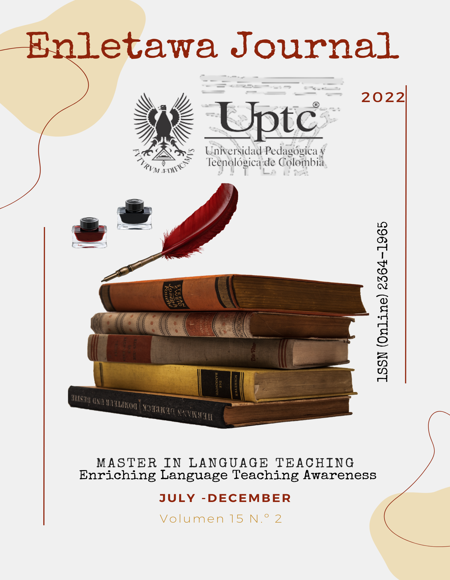Developing Spanish oral Skills Through Argumentative Activities Focused on the Arhuaco Culture

Abstract
This article describes the implementation of argumentative activities focused on the Arhuaco Culture, and its effect on senior highschooler’s oral skills. We carried out a qualitative study and implemented one action research cycle: the action phase consisted of a pedagogical intervention of 3 applications (4 class periods each one). During the observation phase, we collected data, and for the reflection phase, we analyzed such data. Triangulation and data reduction allowed us to identify patterns and propose two categories of analysis as initial findings. We concluded that students knew few argumentative methods, but by dealing with topics in an interactive way or topics that were interesting to students, they told many arguments to defend their ideas. The intercultural lessons focused on the Arhuaco culture improved students' argumentative skills since they could be contextualized to back up some of their ideas. The intervention also allowed the students to see Colombia as a multicultural country
Keywords
pedagogical intervention, action research, senior high schoolers, oral argumentative skills, Arhuaco Culture
Author Biography
Jessica Juliette Duque Briceño
Active Bachelor’s student in Bilingualism
Juan Carlos Malagón Viasus
Active Bachelor’s student in Bilingualism
Diana Marcela Vásquez
Active Bachelor’s student in Bilingualism
Judith Castellanos Jaimes
full-time professor at the School of Education at Universidad El Bosque. She holds an M.A. in Applied LInguistics to TEFL fromUniversidad Distrital Francisco José de Caldas and a B.A in Languages from Universidad Industrial de Santander
References
- Ardila, O. (2010). Las lenguas indígenas de Colombia. UniversOS , 205. Retrieved from https://www.uv.es/calvo/amerindias/numeros/n7.pdf#page=28
- Arias, M., Melo Parra, L.C., Dueñas Betancourt, J. P & Pantoja Parra, J. M. (2017), La cultura popular como medio para reconocer las lenguas nativas en Colombia. Universidad del Rosario. Retrieved from http://repository.urosario.edu.co/handle/10336/13073
- Blaxter, L., Hughes, C., & Tight, M. (2010). How to Research. [E-book]. McGraw-Hill Education. Retrieved from: https://eduwavepool.unizwa.edu.om/lmsdatapool/00008299/LearningObjects/How%20to%20Research.pdf.
- Billups, F. D. (2021). Qualitative Data Collection Tools. Retrieved from https://books.google.com.co/books?id=JQeDwAAQBAJ&printsec=frontcover&dq=instruments+of+data+collection&hl=es&sa=X&redir_esc=y#v=onepage&q&f=false
- Burns, A. (2009). Action Research in Second Language. The Cambridge guide to second language teacher education, 289--297. Retrieved from https://www.semanticscholar.org/paper/Action-research-in-second-language-teacher-Burns/aeed23d61aca4d81cef5dd03a199e4b6cc4a18d1
- Calderón, D. I. (2009). El lugar de la argumentación en el currículo colombiano. nodos y nudos, 3(27). Retrieved from https://revistas.pedagogica.edu.co/index.php/NYN/article/view/10111
- Freeley, A. J., & Steinberg, D. (2013). Argumentation and Debate. Cengage Learning.Retrieved from https://books.google.es/books?hl=es&lr=&id=1Y0WAAAAQBAJ&oi=fnd&pg=PP1&dq=argumentation&ots=sbzyf1VEbZ&sig=V_5TM261sG4X9az4R8orIn22WhI#v=onepage&q=argumentation&f=false
- Grosjean, F. and Miller, J. L. (1994). Going in and out of Languages: An Example of Bilingual Flexibility. Psychological Science, 5, 4, pp. 201-206. Retrieved from https://www.francoisgrosjean.ch/bilin_bicult/24.%20Grosjean%20&%20Miller.pdf DOI: https://doi.org/10.1111/j.1467-9280.1994.tb00501.x
- Lestyan, A. (2019, september 25). Various Ways of Knowing: Perspectives on Human Sensory Discernment in Visually Restrictive Immersive Environments. Retrieved from Academia Accelerating the world's research. https://d1wqtxts1xzle7.cloudfront.net/61213753/Adrienn_Lestyan_Various_Ways_of_Knowing_MT2019_full20191114-76378-19epg5q-with-cover-page-v2.pdf?Expires=1650848071&Signature=JwExCJ4FbB9Ur6CRJimtW1Bi2JyffumLtpoqOVZ85H~-SY2lM9Ra-8IEsZyTVqQfOc6zHoMxoMNTWMb1~W
- De Mejía, A. (2006). Bilingual Education in Colombia:Towards a Recognition of Languages, Cultures and Identities. Colombian Applied Linguistics Journal, 8, 152-168. Retrieved from http://www.scielo.org.co/pdf/calj/n8/n8a08.pdf DOI: https://doi.org/10.14483/22487085.176
- Mettetal, G. (2001). The What, Why and How of Classroom Action Research. in Journal of the Scholarship of Teaching and Learning, 10.Retrieved from https://www.researchgate.net/publication/242179106_The_What_Why_and_How_of_Classroom_Action_Research
- Ministerio de Cultura República de Colombia. (2010). Cultura es independencia. Retrieved from Cultura es independencia: https://www.mincultura.gov.co/areas/poblaciones/noticias/Documents/Caracterizaci%C3%B3n%20del%20pueblo%20Iku%20(Arhuaco).pdf
- Ministerio de Educación (2006). Estándares Básicos de Competencias en Lenguaje, Matemáticas, Ciencias y Ciudadanas. Bogotá. Retrieved from https://www.mineducacion.gov.co/1621/articles-340021_recurso_1.pdf
- Ministerio de Educación Nacional República de Colombia. (1984). Decreto 1002 de abril 24 de 1984. Retrieved from. https://www.mineducacion.gov.co/1621/article-103663.html
- Núñez Pardo, A. & Téllez Téllez, M. (2012). Using debate in the classroom: a pedagogical strategy for the development of the argumentative fa foreign language. Bogotá: Publicaciones Universidad Externado de Colombia
- Phillips, D. K., & Carr, K. (2015). Becoming a Teacher Through Action Research: Process, Context, and Self-Study. En Becoming a Teacher through Action Research: Process, Context, and Self-Study (3rd ed., p. 12). Routledge. DOI: https://doi.org/10.4324/9781315867496
- Phillippi J, Lauderdale J. A Guide to Field Notes for Qualitative Research: Context and Conversation. Qual Health Res. 2018 Feb;28(3):381-388. doi: 10.1177/1049732317697102. Epub 2017 Apr 5. PMID: 29298584. DOI: https://doi.org/10.1177/1049732317697102
- Reigeluth, C., & Karnopp, J. (2013). Reinventing Schools: It’s Time to Break the Mold. R&L Education. Retrieved from https://books.google.es/books?hl=es&lr=&id=Bs0sXG3H9-EC&oi=fnd&pg=PR5&dq=reigeluth+2013+reinventing+schools&ots=ixvPmqVsWF&sig=Ia_H95vNJ-M-1zx3ksxiSqQk2zo#v=onepage&q=reigeluth%202013%20reinventing%20schools&f=false
- Stolp, S. (1994, june). Leadership for School Culture.Eric Digest 91. Retrieved from 1994 https://scholarsbank.uoregon.edu/xmlui/bitstream/handle/1794/3312/digest091.pdf
- Trujillo, O. E., Miranda, I., & De la Hoz Molinares, E. (2018). Los sistemas de medida en la comunidad Arhuaca. Revista Latinoamericana de Etnomatemática, 50. Retrieved from https://dialnet.unirioja.es/servlet/articulo?codigo=7530475
- Tudor, I. (2021). The Dynamics of the Language Classroom. Cambridge: Cambridge University Press. Retrieved from https://books.google.com.co/books?hl=es&lr=&id=D3evOkPRJgEC&oi=fnd&pg=PA5&dq=The+Dynamics+of+the+Language+Classroom.+Cambridge&ots=oziPy3wngn&sig=_OrlR8Pgi-YExArz3_DLjgbMuFk#v=onepage&q=The%20Dynamics%20of%20the%20Language%20Classroom.%20Cambridge&f=false
- Urrutia, W. & Vega, E. (2010) Encouraging teenagers to improve speaking skills through games in a Colombian public school. Profile 12, (1), 11-31. https://dialnet.unirioja.es/servlet/articulo?codigo=4858466
- Williamson, Graham & Prosser, Sue. (2002). Illustrating the ethical dimensions of action research. Nurse researcher. 10. 38-49. 10.7748/nr2003.01.10.2.38.c5887. Retrieved from https://www.researchgate.net/publication/10958295_Illustrating_the_ethical_dimensions_of_action_research DOI: https://doi.org/10.7748/nr.10.2.38.s5
- Xu, M.A. and Storr, G.B. (2012) Learning the Concept of Researcher as Instrument in Qualitative Research. The Qualitative Report, 17, 1-18. Retrieved from https://www.proquest.com/openview/efc446d291f7395d6178ccdd2c16fe93/1?pq.
